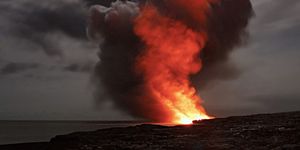New Method for Rainfall Simulation
Land use, or what humans use their land for like agriculture, residential, or industrial purposes, has a big impact on the water quality of a stream or lake. Impervious surfaces cause water to move into streams more quickly, contributing to erosion. Urban and agricultural lands add nutrients, pesticides, and pollution from runoff that contributes to poor water quality. Improving the quality of the land to reduce the speed and chemical contents of rain runoff is a great way to improve water quality.
One of the ways we can improve runoff from agricultural lands is to implement conservation practices. Farmland conservation practices are important, not only for farmers to make the most of their land and make more money but also for the environment as a whole. Crop rotation, riparian buffers, efficient fertilization and irrigation practices, and many other activities can help improve the soil quality to retain more water and prevent excessive chemical runoff.
Measuring the effects of different farming practices on the landscape can be difficult, particularly on short time scales and small areas. The interactions between soil types, topography, and amount of rainfall are very difficult to separate. Computer models can fill these gaps, but they must have evidence to back them up. Scientists at the Stroud Water Research Center have come up with an inventive solution to look at how rainfall affects water quality that runs off different landscapes. They’ve built a precise portable rainfall simulator that can imitate rainfall under very controlled, known conditions on any particular piece of land. This allows them to investigate different kinds of rainfall on properties with different land use, plant species, or soil compositions with very few other variables, unlike natural rainfall that cannot be controlled.
This research can support the modeling efforts of researchers all over the globe and potentially be adapted by other researchers for their own sites. While this new method hasn’t yet been used for urban sites, there are opportunities for this technology to be used in many different ways.
Sources: Stroud Water Research Center, IOP Conference Series: Earth and Environmental Science, Lincoln University, 8th World Congress on Conservation Agriculture









